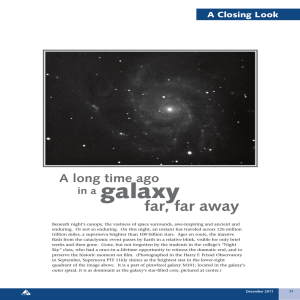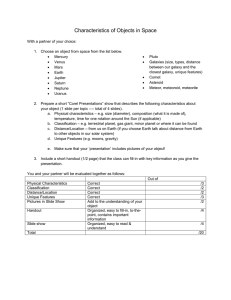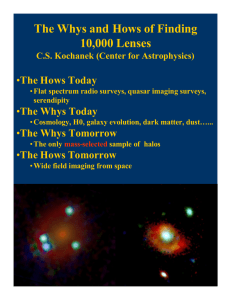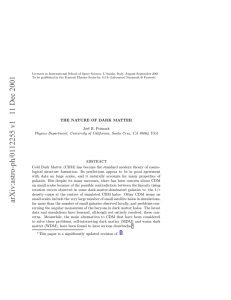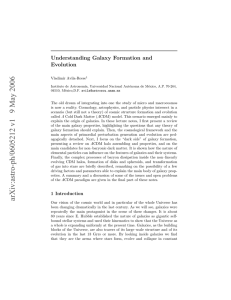What do we need to know about galaxy formation? rachel somerville
advertisement
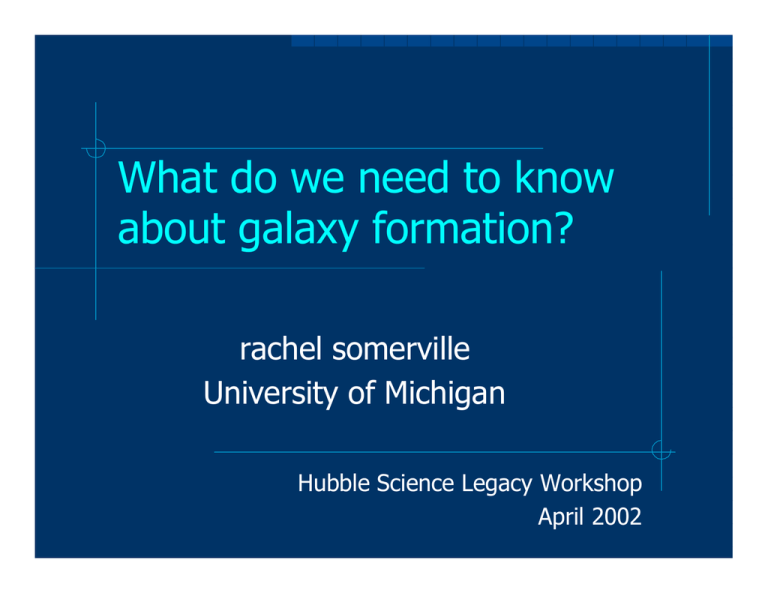
What do we need to know about galaxy formation? rachel somerville University of Michigan Hubble Science Legacy Workshop April 2002 what’s next? test the CDM paradigm constrain the nature of the dark matter and dark energy gain better understanding of “gastrophysics” n cooling – star formation – feedback – dust – chemical enrichment – role of BH/AGN – magnetic fields… MW (-20) SMC (-16) Sculptor (-10) HST (V606) diffraction limited 10m at V galaxy observations with NHST kinematics and stellar populations of dwarf galaxies (z<1) high resolution (sub-kpc) imaging and kinematics of more luminous intermediate to high redshift galaxies (1<z<5) trouble for CDM? problems on small scales too much substructure on dwarf galaxy scales? dark matter halos too “cuspy” in center? angular momentum distribution J(r) incompatible with exponential disks? the substructure “crisis” Moore et al. 1999 Klypin et al. 1999 Font et al. 2001 Gnedin 2000 resolved by photoionization? see also Bullock, Kravtsov & Weinberg 2000; Benson et al. 2002 rss rss2002 2002 The faint-end slope of the luminosity function: is there an environmental dependence? CDM prediction: prediction in dense environments, more dwarf halos collapse before re-ionization àdwarf-to-giant ratio larger in over-dense regions Tully, rss, Trentham & Verheijen 2002 search for barren dark halos dwarf groups with very high mass-tolight ratios (Tully, rss, Trentham & Verheijen 2002) direct detection via lensing (Metcalf & Madau 2001)? what do we expect to see at z=3? predictions from semi-analytic models cusps and angular momentum are CDM halo mass profiles consistent with galaxy kinematics? n n need complete samples to understand statistics need to understand how baryons modify profiles is the angular momentum profile of halos predicted by CDM consistent with the structure of galactic disks and spheroids? n n segregation: JDM à Jbar (magnitude and direction) transfer w bars/spiral arms, viscosity w feedback (SN/AGN)? mass galaxy mass profiles stellar radial velocities high resolution kinematics from sub-kpc to 100 kpc scales can constrain properties of DM halos + modification by baryons radius (kpc) stellar/gas kinematics satellites & lensing Angular momentum conserved ΛCDM models for the Milky Way Angular momentum transferred Klypin, Klypin,Zhao Zhao& &rss rss2002 2002 density cusps destroyed by primordial rotating bars? radius (units of bar radius) Weinberg & Katz, preprint star formation what determines how efficiently a galaxy can turn cold gas into stars? how does this efficiency scale with redshift/galaxy properties? what is the physical basis of empirical scaling laws (e.g. Kennicutt) is the IMF universal in space and time? why does it have the observed shape? star formation in galaxies study Kennicutt-type relations at z>2 with ALMA + new Hubble? Kennicutt 1998 spatially resolved star formation histories from fossil evidence Ellis et al. 2001 feedback what does the energy from massive stars and SN do to the ISM/IGM/ICM? how does this impact future generations of stars? n n n positive/negative? thermal/kinetic/pressure? turbulence/outflows? what about AGN? heavy elements and dust how efficiently are metals expelled from DM halos? n n efficient early enrichment of IGM thermal signatures what determines the degree of optical/UV extinction a galaxy experiences? n n n mass of dust? dust geometry, density, composition? age of stellar population? The Bolometric Madau Diagram um lyntois st u d l r a st wa ve len gt h t h ig if h s d re t rss in prep what determines galaxy “type”? which of the many observational “sequences” are truly fundamental? n B/T, V/σ, color, spectral type… when was the Hubble sequence as we know it established? n n role of mergers spheroid formation scaling relations what is the physical origin of scaling relations like the Tully-Fisher relation and the fundamental plane? why do they have so little scatter? the merger rate as a function of epoch a direct test of the hierarchical assembly of galaxies Brinchmann & Ellis 2000 Le Fevre et al. 2000 measure the merger rate as function of environment, redshift galaxy type, mass, luminosity to z=5 Ferguson et al. 2001 Wish list: super-Sloan high resolution kinematics and multiband imaging for complete sample of galaxies, reaching well below L* (z=0-5) multiphase information: neutral, ionized, and molecular gas metallicity indicators dust content (FIR/UV) coordinate with IGM and lensing data
